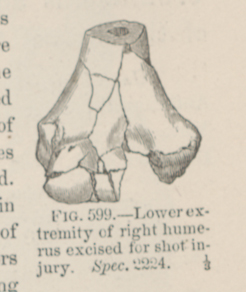Title: Murtagh, J.
Source text: The Medical and Surgical History of the War of the Rebellion. (1861-65.), Part 2, Volume 2 (Washington, DC: Government Printing Office, 1876), 847.
Civil War Washington ID: med.d2e31445
TEI/XML: med.d2e31445.xml
CASE 1777.—Private J. Murtagh, Co. B, 69th New York, aged 30 years, was wounded at Fredericksburg, December 13, 1862. Surgeon D. W. Bliss, U. S. V., reported the following history and contributed the specimen (FIG. 599): "The patient is a native of Ireland, of sanguine temperament, robust figure, strong constitution, has always enjoyed good health, and has been in the service four months. He was wounded at 1 P. M., while in the act of firing, the ball taking effect in the right arm. He laid on the field until dark, and then walked more than a mile, into Fredericksburg, where he remained until the next morning. He was carried in an ambulance wagon to Alexandria, where his arm was bandaged and he was placed on board of a transport for Washington. December 14th, he was admitted to the Armory Square Hospital in the night, and no examination was attempted. December 15th, the general condition of the patient is good. Examination showed that the ball entered a little above the external condyle and emerged a little below the internal, causing a compound comminuted fracture of the humerus. The operation of resection was decided upon, and performed at 2 P. M. An S incision was made, commencing two inches above the elbow and extending the same distance below. The bone was found most terribly shattered. Both the condyles were removed, and the bone, as far as denuded of periosteum, taken off with the chain saw. In all, about three inches of the lower end of the humerus was removed, and numerous spiculæ of bone were taken out. The ulna and radius were uninjured, as were also the attachments of the extensors and flexors of the arm. The incision was closed by sutures, the wound where the ball made its exit being deemed a sufficient opening for the discharge of the pus which may be formed. December 16th, the patient has stood the operation well and appears comfortable." On May 12th, the patient was transferred to De Camp Hospital, David's Island, New York Harbor, whence Acting Assistant Surgeon J. W. Dickie reported the following result in the case: "The wound was healed when admitted. There is a space of about one inch between the bones of the upper and lower arms. The motion of the wrist and fingers is not affected. With this exception the arm is useless, as there is no motion, except passive, of the elbow joint. The tissues around the joint are tender." On June 25th, the patient was transferred to the Veteran Reserve Corps at Fort Schuyler, and on April 29, 1864, he was discharged from service and pensioned. In September, 1865, the pensioner was supplied with an apparatus by Dr. E. D. Hudson, of New York City, who described the injured arm as being "shortened one and a half inches." Examiner B. A. Watson, of Jersey City, December 11, 1873, certified: "Gunshot wound of right elbow, followed by excision. The arm hangs powerless at his side. This disability is equal to the loss of a limb for all purposes of manual labor, is total, third grade, and permanent." This pensioner was paid June 4, 1875.
